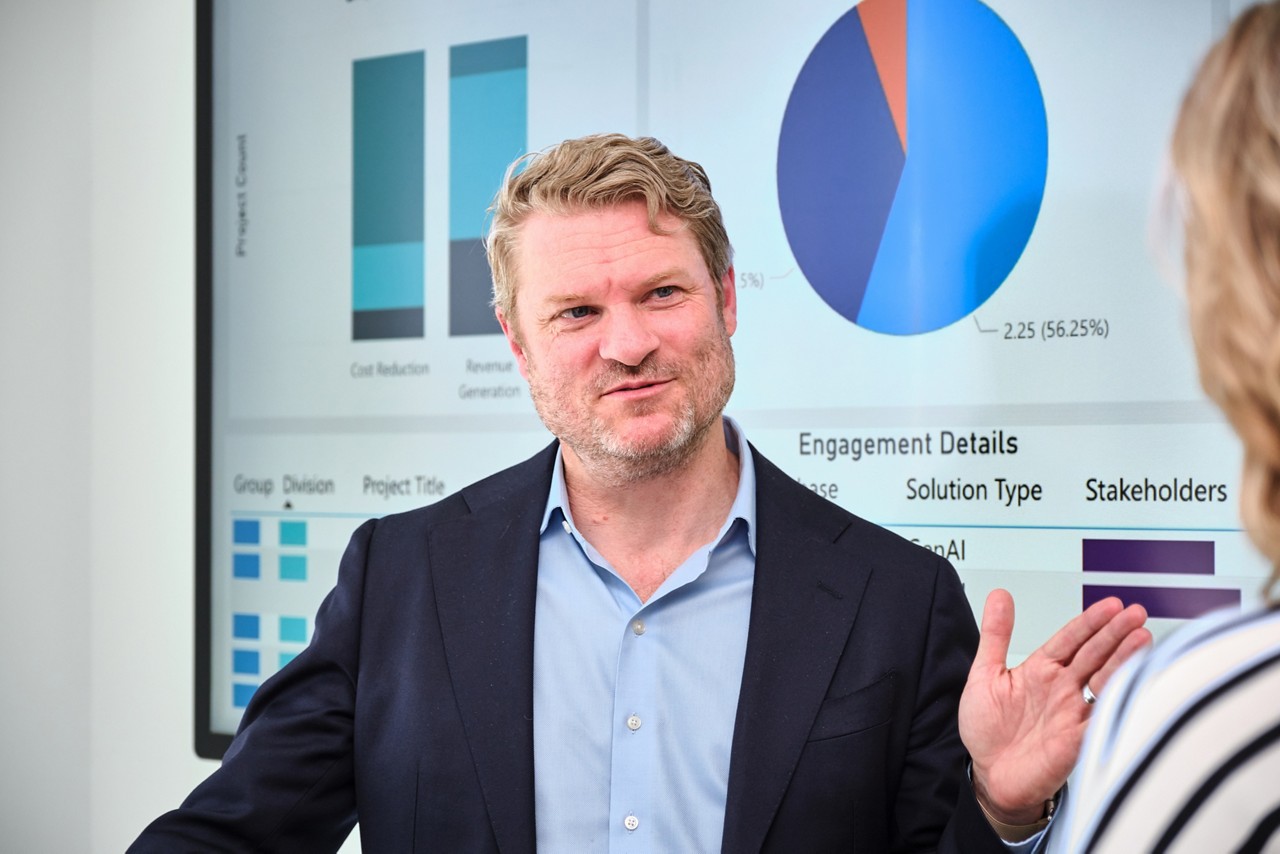As the Information Technology leader for Thermo Fisher Scientific, Ryan Snyder is often asked about AI.
Where is it headed?
How can we harness it to our benefit, and, more importantly, to better serve the company’s customers?
He and his team spend a lot of time on these questions and on solutions designed to leverage the immense opportunity AI provides, while working to stay ahead of ever-evolving features, applications and potential risks.
At the end of the day, Ryan relies on building and maintaining a strong IT foundation to support AI’s fast-paced evolution to ensure Thermo Fisher is maximizing the potential to drive innovation, serve customers and equip colleagues around the globe.
We caught up with Ryan to talk all things AI.

Q. How are major advancements in AI changing the way we work? How is Thermo Fisher thinking about the value AI can create now and over time?
A: AI is unlike any other disruptor we’ve seen since the wide adoption and evolution of the internet, and it’s already embedded in most of the tools and the applications we use daily, whether we realize it or not. We have quickly become accustomed to our email tool completing our sentences and our search engines summarizing answers.
AI is already requiring us to think, innovate and prioritize differently. Even in the short time since generative AI tools like ChatGPT burst onto the scene broadly, we’ve gone from using them for simple inquiries to interacting with them iteratively to help us think through problems, analyze information and build on our own expertise.
At our company, we are directing AI investment toward practical and specific applications of the technology to most effectively realize value in the near term—and to create a strong culture of innovation and market standing in the long term.
It will take time to see all the best use cases for AI, but it’s clear that given the time it takes to learn and apply these tools, those who are getting a head start will have a measurable leg up later.
Within Thermo Fisher, we see the value of AI in three primary areas – we can use it to enhance our products and services, create a better experience for our customers and help us work more efficiently across our company.

Q: Our customers are eager to understand how AI can accelerate their capabilities. How is Thermo Fisher thinking about enabling customers with AI in its products and services?
A: For several years, we have enabled our customers to accelerate their science and improve their productivity through cutting-edge technologies.
Our digital product footprint is growing; Thermo Fisher Connect Enterprise platform brings orchestration and connectivity across lab ecosystems, and embedded AI/ML in our products –including cell analysis, electron microscopy, mass spectrometry and proteomics offerings – can highlight significant data segments, enhance imaging and analysis, increase precision and accuracy of results and replace manual steps.
For example, AI capabilities in our Invitrogen™ Countess™ 3 Cell Counters clarify imagery, reducing guesswork and error for scientists analyzing the health of cells for a variety of applications, including cell therapy and molecular biology.
We have several software products that leverage AI to help customers analyze the large volume of data generated by our electron microscopy and mass spectrometry instruments, freeing them up to focus on more complex tasks.
In our clinical research space, AI capabilities are already accelerating processes and driving operational efficiency for our clinical services customers. Our software, when paired with machine learning models, can provide key insights that help with clinical trial planning and management, including identifying optimal sites and more accurately forecasting enrollment milestones.
At the end of the day, our customers are looking to us to help with four core needs. How can we help them:
- Improve their own productivity
- Drive novel insights via AI
- Automate scientific workflows
- Address their cybersecurity and regulatory considerations
We know that embedding AI/ML capabilities within our products and services enables us to stay at the leading edge of serving science, and we are working closely with our customers to best understand where that AI will be most beneficial for them.
Q: In terms of improving experience, how are you thinking about AI within the digital touchpoints Thermo Fisher has with its customers?
A: Improving the customer experience is a constant goal and a bar we continue to raise. Our customers will be able to do business with us more seamlessly through AI-enabled eCommerce and support. We’re also building connectivity within the company to provide an optimized experience for our customers no matter what they are hoping to buy or learn.
Improving the customer experience also includes how we enable our customer-facing colleagues who interact with customers, ensuring they have AI-driven personalized marketing content to support more relevant conversations with their customers. And our support teams are also able to drive faster and more accurate resolution of customer inquiries with our AI tools.
Q: As its leader, what is the role of IT in enabling AI at Thermo Fisher?
A: As an IT organization, our goal is to help provide foundational support while encouraging the broader organization to build and explore responsibly.
One of the greatest challenges and unique opportunities we have is providing a partnership with our businesses that best allows the broader company to leverage its breadth and depth.
Our digital touchpoints—which provide access to products and services across many market segments—provide chances to show up as Thermo Fisher, a single trusted partner with a single, profoundly impactful mission.
Finding ways to connect our products and services to provide our customers with an integrated, informed and thoughtful experience will be imperative to meet consumer expectations around ecommerce and will help our customers continue to forge meaningful relationships with a trusted brand.

Q: How is Thermo Fisher itself utilizing AI? Any insights to share on adopting AI within an organization?
A: At Thermo Fisher, we immediately recognized that realizing the full power and potential of AI starts with our colleagues, so our teams are well-positioned to support customers with innovative ideas and solutions.
We have an internal generative AI platform, which allows colleagues to leverage this cutting-edge technology in an environment exclusive to Thermo Fisher, and we have prioritized building enterprise-wide literacy and adoption. Our colleagues are empowered to explore how generative AI can help them in their day-to-day work, and we’ve seen diverse and exciting use cases that enhance our business processes.
From boosting the speed and quality of software engineering to content generation to content creation for marketing and product materials to rapid search and summarization of standard operating procedures, these transformations enable efficiency and allow our teams to spend more time on value-added work, ultimately improving the overall colleague experience. Our future-ready workforce is absolutely part of our value proposition.
Q: How is Thermo Fisher balancing the promise of AI with using the technology responsibly?
A: First and foremost, we emphasize the importance of using AI responsibly to all our colleagues. At Thermo Fisher, we have built a Responsible AI (RAI) Framework and set up an AI Technology Council to guide the organization in matters of security, privacy and regulatory concerns.
AI is also changing how we think about data capabilities, generation and governance, because without data, there is no AI. As both Thermo Fisher and our customers are generating huge quantities of it—operational, scientific, behavioral and others—we have to consider how to unlock its full potential responsibly.
More and more, customers are looking for data products with elements of FAIR (findability, accessibility, interoperability and reusability). That can be a tall order, especially when considering the complexity of the organizations and institutions storing and analyzing this information.
How can we leverage the data we produce as a company to improve our offerings to customers? What digital solutions can we provide to allow customers to devote more of their time to accelerating science and gleaning insights rather than managing and analyzing data manually? These are questions we ask ourselves continuously.
Q: We know you don’t have a crystal ball – but what do you think the future holds for AI and its applications?
A: A lot of leaders in the industry are considering how AI agents may change human roles and responsibilities in the long run.
The evolution of AI—particularly as it relates to agents and the concept of reason—will transform systems, reshape roles, evolve workflows and change how we engage with processes. Staying ahead of the curve with agents will allow colleagues more time for strategy and decision making.
There are also interesting discussions right now around democratization of AI and data capabilities and insights. When approached thoughtfully, the ability to share and use these technologies more effectively can have profound impacts on internal productivity, innovation in development and time to market—which can make a big difference for our customers and the human lives they can affect.
Our customers are doing amazing things every day, and our aim is always to enable their work. We’ll work collaboratively to understand where AI can add value for them by helping them do even more, go faster or remove barriers. Our robust leadership in the AI space, our intensity around innovation and our dedication to prioritizing customers’ needs make us a strong partner as AI capabilities and application continue to evolve and expand.

